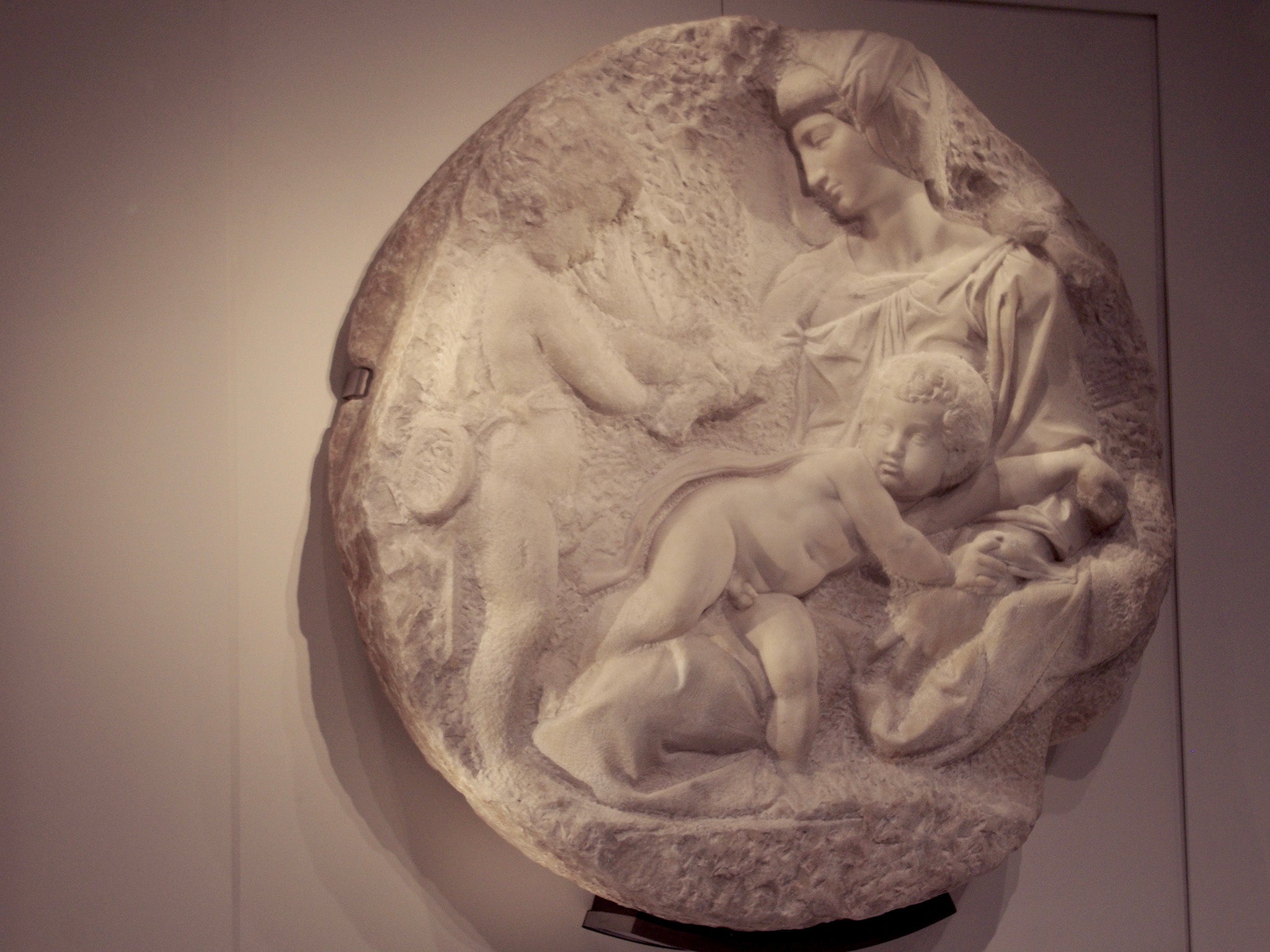Should the Royal Academy sell its Michelangelo to stay afloat?
Kevin Childs argues that it would be shortsighted because the Academy is the sum of its collections. But if it decides to keep it could it please be given a more fitting display


Consider the scene as the grandees of the Royal Academy meet this week. It might be a painting by Zoffany or Reynolds. Academicians debating, ill-concealed anger, rhetorical gesticulations, some resting their hands on their chins in sullen resignation. One raises his arm heavenward as he suggests the impossible: that they sell one of their artworks to help keep jobs at the institution. And not any old artwork. A sculpture by one of the greatest artists, Michelangelo.
I don’t want anyone to lose their job in these hard times – God knows, I’ve lost enough work myself over the last few months through cancelled teaching and lectures – but that’s only one reason why I’m less disturbed by the sale of the sculpture than others.
It “crosses a line” according to The Telegraph’s Alistair Sooke. It’s a “cruel dilemma” for Vanessa Thorpe in The Observer. But as always, whatever the Academy decides, the issue is much more intricate than any of these opinations suggest.
The Taddei Tondo is an unfinished relief sculpture in Carrara marble of the Virgin and Child with the Infant St John. It’s round (hence “tondo”) and was begun by Michelangelo, according to the artist and biographer Giorgio Vasari, for a man called Taddeo Taddei (hence the other part of its name) in about 1504 when the artist was 29.
Michelangelo was completing his great early masterwork, David, at the same time, but was clearly unwilling to turn down other commissions as he agreed to take on this complex subject and a further sculpted tondo for one Bartolommeo Pitti. Neither were completed, however. In the case of the RA’s sculpture, Michelangelo either discovered a minor fault in the marble around where the Virgin’s face is, or simply abandoned it when he was summoned to Rome to design a tomb for a far more illustrious patron, Pope Julius II.
His failure to complete the tondo is, ironically, our gain: it offers a brilliant insight into how he worked. Having said that, there weren’t many sculptures he actually completed, leading to a whole raft of literature in the 19th century about his apparently intentional unfinishedness, or non finito as contemporaries referred to it.
The critic Walter Pater described this attribute as “surely not always undesigned”, suggesting with characteristic hedginess – you could call it negative negativity – that the incompleteness was what gave his sculpture its sense of life or dynamism. He may have had a point. A French contemporary of Pater, Eugène Guillaume, saw it as a quest for “infinite suggestiveness”.
The Taddei Tondo has much to recommend it in terms of “infinite suggestiveness”. The three figures seem to emerge, half-formed, from the marble block, certain limbs or body parts more finished than others. The mass of chisel and claw hammer marks that make up the background are like a sort of petrified chaos or marble potage from which they struggle to escape.
The Christ Child wriggles and squirms across his mother’s lap away from St John, who offers him a small captive bird, probably a goldfinch, although the barely registered carving here makes it difficult to identify. To the medieval mind, in a world of bestiaries and natural symbolism, the goldfinch signified Christ’s Passion.
According to one post-Biblical tale, while Christ was carrying the cross to Calvary a goldfinch came and perched on it and then removed one of the thorns from his brow, splashing itself with his blood in the process. Some give this role to the robin, but whichever the bird, it clearly spooks Michelangelo’s Christ Child with premonition of his coming ordeal.
The faces of mother and child, and much of his torso are brought to a high finish. St John remains roughly blocked out. You could be forgiven for seeing these varying levels of carving, the sketchy John, the more rounded Christ and the Virgin who is somewhere in between them, as helping to dramatize the story. Michelangelo’s contemporary, Benedetto Varchi, thought these incomplete works “showed and still show the depth and excellence of his intellect and genius”. Michelangelo himself described his process of creation in one of his poems, how the forms were already there in the marble, or at least the “idea” of them, and how the artist’s role was to release them. The release was always difficult, a struggle even, and didn’t necessarily require a final polish.
It would be sad for the country to lose its only full-scale Michelangelo, and even sadder if it went to a private collection never to be seen again
The tondo remained with the Taddei family until it was bought by a collector in Rome and subsequently came into the hands of Sir George Beaumont, one of the founders of the National Gallery in London. He bequeathed it to the Royal Academy as both a valuable work of art and an invaluable teaching aid for would-be sculptors. Every mark on it tells a story and offers an unprecedented insight into the technique of a great artist. The tondo gained much fame and appreciation as the only marble sculpture by Michelangelo in the country – there’s otherwise a tiny wax model by the same artist in the Victoria and Albert Museum.
All this history brings me to the present day. The Royal Academy’s annual Summer Exhibition has just opened, rather later than scheduled, and hopeful as well as well-established artists once again jockey for space and recognition. At the same time, the directors are proposing massive job cuts to fill a giant multi-million-pound hole in their finances. Should they sell off their prized artworks to stay afloat? Is it short sighted to do so when part of the attraction of a place like the RA is the worth of its collections?
Well, until recently, the Taddei Tondo stood at the top of a narrow staircase in a corridor which leads to one of the Academy’s temporary exhibition spaces. It was surrounded by other bits and pieces from the permanent collection, “on the way to the loo”, as someone said. It was unnoticed and unloved. It was almost impossible to stop and appreciate all that “infinite suggestiveness”, and the reflections on the protective glass around it do the rest. What was the point in keeping it?
It’s new display, next to a vast, bad copy of Leonardo’s Last Supper, is hardly an improvement. Imagine the Louvre or the Met or the Uffizi treating a sculpture by one of the greatest artists of all time in this way. It should have its own gallery. Its every ridge and chisel groove should be visible through appropriate lighting. It should be approached with awe, not red-faced indifference by those who’ve made it up the stairs on their way to something else. It should be given space, and its history should be explained. It should be loved. So if the RA can’t do it, let someone else. Sell and be damned.
It would be sad for the country to lose its only full-scale Michelangelo, and even sadder if it went to a private collection never to be seen again. But let me repeat myself, someone else might show it in a better light, in an altogether better condition. Given the right circumstances, why not sell it?
Of course, this may all be a storm in a teacup. The RA has borrowed millions of pounds to create new exhibition spaces and with the enforced Covid-19 closures it is struggling financially. None of this is the fault of the employees who are facing redundancy and would appreciate the injection of cash the sale would provide.
Perhaps the reported discussions are just a play for sympathy, in the hope that someone might come to their rescue. Maybe they’re just rumours. Leading academicians and architectural professors have taken the proposal seriously enough to agree with it. In contrast, the current president, artist Rebecca Salter, has said effectively “not on my watch”, and the chief executive, Axel Rüger, has pronounced such a sale to be impossible (on what evidence I don’t know). But with a hammer price likely to be north of £100 million it must be a temptation.
Like so much of Michelangelo’s work the Taddei Tondo is something of an enigma. That elusive breath which would give these figures life is almost visible across the apparently animated surface of the marble, particularly in a certain raking light. But there are moments of equivocation too. The Virgin’s right hand is only roughly cut, barely blocked out in fact, but enough to suggest a meaningful gesture: is she tenderly stroking John’s face, or warning him off her frightened son?
Perhaps those who have brought the Royal Academy to its current difficulties should take note. Sell it if you must, but whatever you do, give it the love it deserves.




Join our commenting forum
Join thought-provoking conversations, follow other Independent readers and see their replies
Comments